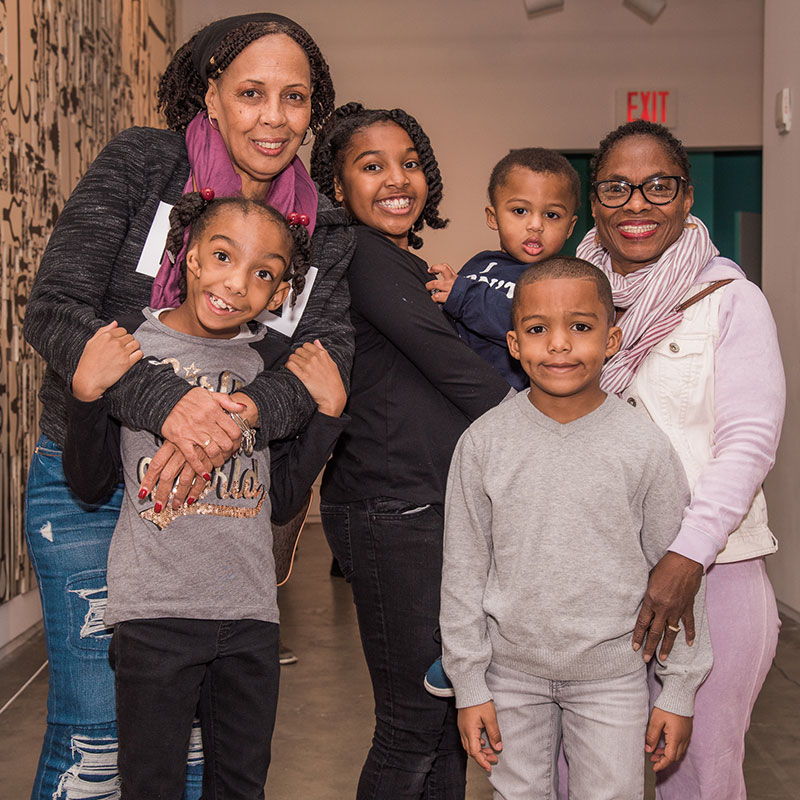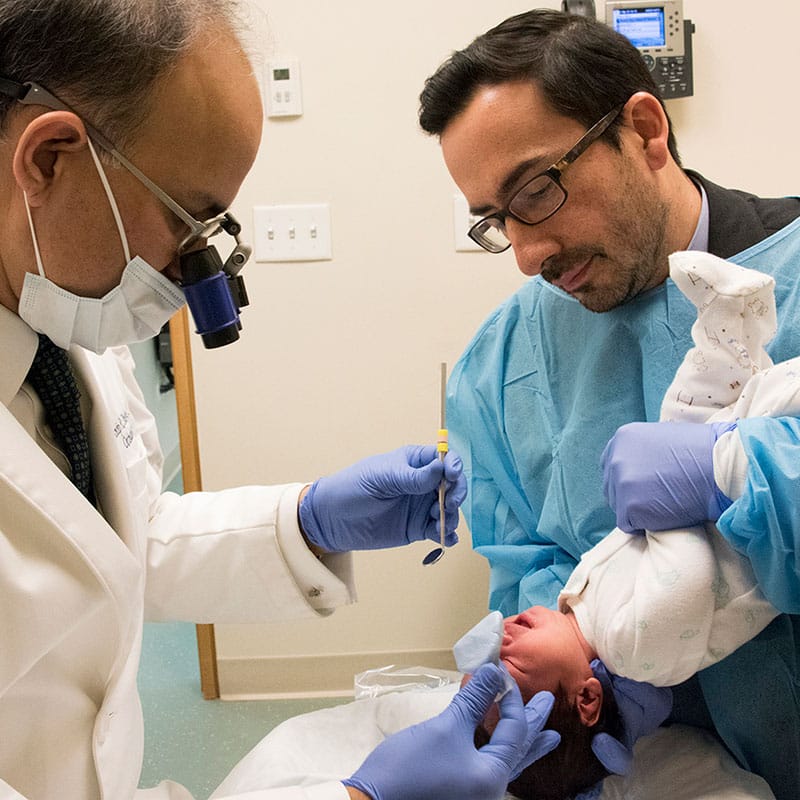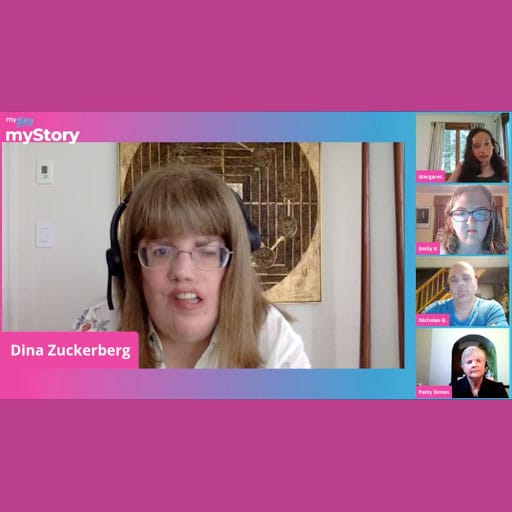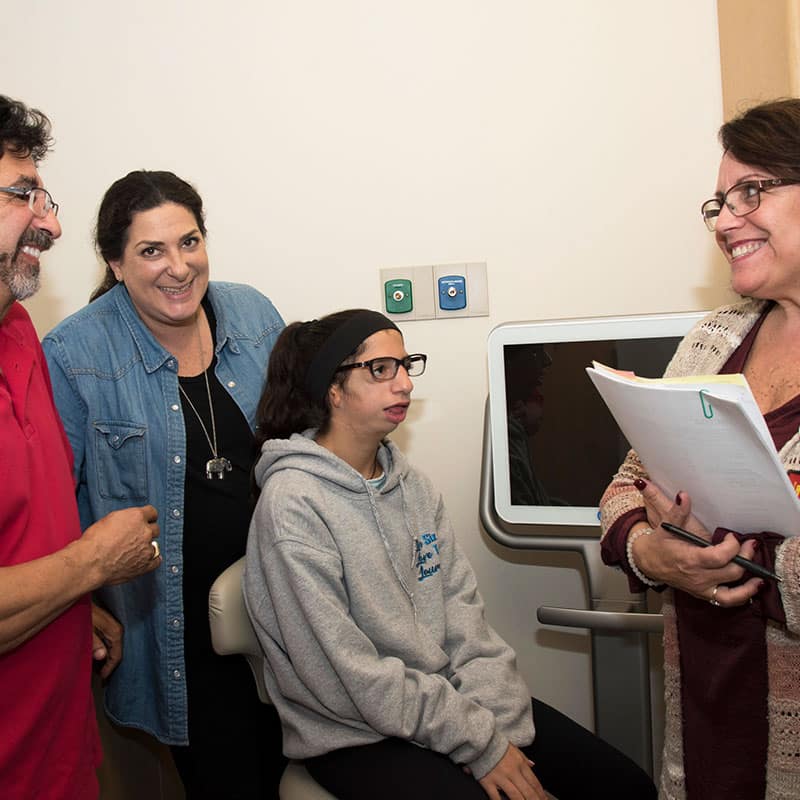Parenting
To download these guides in a PDF, click below:
Parenting: A Guide for Parents of Children with Craniofacial Conditions
Raising children is one of the most difficult, yet rewarding, jobs in the world. However, there are unique challenges associated with being the parent or caregiver of children with facial differences. These challenges include finding appropriate ways of talking to children of all ages about their condition, preparing them for medical procedures, and helping them and their siblings cope with uncomfortable situations and hurtful comments. This guide is designed to help parents and caregivers of children with facial differences address some of the common issues that they encounter.
How Do Children Understand Having a Facial Difference?
How children understand and adjust to having a facial difference depends on the child’s age and level of development. To help their children adjust, it is helpful for parents and caregivers to understand the different development stages.
Infants and Toddlers (Birth – 2 years)
During the first two years of life, infants and toddlers begin to “attach” to their parents and to develop a sense of trust and an overall feeling of security. Attachment is the process by which parents and children bond and parents learn to tend to their infant’s physical and emotional needs by feeding, holding, and soothing the child. This process is very important for a child’s emotional development. Infants and toddlers generally do not understand their medical condition. A hospitalization may disrupt a child’s development of trust in the primary caregiver and sense of security. Parents can facilitate the attachment process by participating in as much of their child’s care as possible while the child is hospitalized.
Pre-School Children (3 – 5 years)
During the pre-school years, children begin to develop a sense of independence. At this stage, children with special needs may begin to understand their medical condition. For example, pre-school children may grasp what it means to feel sick but not what causes the sickness. Their perspective tends to be limited to the way things appear in the moment. If they attend pre-school or daycare, children with facial differences may start to notice that they are different from their peers but don’t yet understand why. As they begin to make comparisons between themselves and others, they may begin to feel self-conscious regarding their physical appearance.
Early School-Aged Children (6 – 8 years)
During the early school years, children are developing a basic understanding that they are different in some way from their siblings and peers. They may notice that they receive special treatment from caregivers. Children with facial differences may ask parents: “Why was I born like this?” or “Why doesn’t my brother have this?” While children at this stage may be able to describe reasons for illness, their reasons may not be logical. Children at this age often engage in “magical” or supernatural thinking. They may believe they caused their facial difference by thinking bad thoughts or by fighting with their parents or siblings. Children at this age are mostly concerned with “fitting in.” They tend to view any differences as negative qualities. Teasing and taunting behaviors are typically most extreme during this developmental stage.
Resolution of these issues is a process that extends into adulthood as children try to accept themselves and learn to appreciate their strengths and acknowledge their weaknesses. Parents can help their school- age child by providing encouragement, spending time doing activities with their child, and speaking with their child about how to best respond to teasing and rejection from others.
Older School-Aged Children (9 – 12 years)
Children between the ages of 9 and 12 are usually able to understand their medical condition in a general way. At these ages, children are going through many physical and emotional changes and may begin to dislike things about themselves. They may feel left out when they miss classes for tutoring or speech or occupational therapy. Parents can help their child find ways to develop interests and skills (e.g., through athletics, art, music, volunteering) that will help them to feel good about themselves. In addition, when a child requires an absence from school due to a surgical procedure, parents can help their child stay connected to their classmates via emails and cards.
Adolescents (13 – 17 years)
Teenagers are most concerned with issues of identity and fitting in with a peer group. Adolescents go through rapid physical changes, including growth spurts and hormonal changes that may impact the appearance of facial bones and features. Self-image and attractiveness to others becomes very important during adolescence. Self-confidence can decline when a teenager’s appearance is altered by a facial condition. Teenagers who are different in any way can find their years in high school to be emotionally challenging. For adolescents with facial differences, these challenges can be particularly intense. In a positive light, children at this developmental stage are also concerned about fairness and being a good person. Peers may, therefore, be more open emotionally to people they perceive as different from themselves.
Late Adolescence and Early Adulthood (18 – 25 years)
During late teens and early twenties, people’s feelings about themselves and attitudes toward others can change dramatically. While certain attitudes may persist, older adolescents and young adults often become more tolerant and accepting of differences. During this time in life, people begin to focus less on appearance and more on expanding their social circles to include peers with whom they have shared interests. In addition, young adults start to let go of the anger or insecurities that they may have experienced in the past as they begin to value their own strengths and differences.
How to Talk to Children About Their Facial Differences
It can be challenging to know when and how to talk with children about their facial differences. Many parents find it helpful to begin to talk to their children about their facial differences at three years of age or even earlier. Working information about facial differences into everyday conversation prevents the topic from becoming taboo. For instance, a doctor’s appointment can be a natural time to discuss a child’s condition. A parent may explain to a young child, for example, that he is going to the doctor who is going to help fix his lip.
It is helpful for parents to use age-appropriate, non-medical language to speak with their child about a facial difference. This means that the level of detail a parent provides will change as the child develops. It is important for parents to be open and honest and to answer, to the best of their ability, all of their children’s questions about their medical condition.
The hospital’s or the craniofacial team’s psychologist or social worker can recommend language to use, suggest books to read, and help parents decide how and when to address issues about surgery. Since each situation is unique, the best timing and approach will differ from child to child.
The Genetics Evaluation
Guidelines for discussions with children about their facial difference
- Be open and honest about your child’s medical condition.
- Provide information in language that your child can understand. Use non-medical terms when possible.
- When describing the condition, think about how the information will affect your child. Check to see if your child has understood and consider how your child will use the information with others.
- Assure your child that you are available to answer any questions about the condition and related treatment. If you do not know the answer, promise to find out.
- Be careful not to give too much information at one time. Do this by gearing explanations to your child’s level of understanding.
- Make an effort to help your child deal with emotional reactions by providing support, listening, and giving your child time and space when needed.
- Offer guidance to your child on how to talk with others about the condition. Suggest various simple explanations. Practice with your child ways to explain the condition to other children or to adults.
- Maintain open lines of communication with your child because a child’s thoughts and feelings about the condition may change over time.
Parents who are concerned that their child is having problems coping with a facial difference should speak with their child’s health care provider or craniofacial team. In particular, parents should ask to speak with the craniofacial team’s psychologist or ask for a referral to a mental health professional who has experience working with children with chronic medical conditions.
How to Prepare Children for Medical Procedures and Surgery
The more children and their families are prepared for a surgical procedure, the better they will be able to cope with the event. Below are recommendations to help parents prepare their child, themselves, and the rest of the family for their child’s surgery. Parents need to know what to do beforehand, during the hospital stay, and afterwards.
What parents need to do before their child’s surgery
- Well in advance of the date of surgery, make an appointment to meet with members of your child’s craniofacial team. The team usually includes the surgeon, nurse or nurse practitioner, psychologist, social worker, and sometimes the hospital’s child life specialist. These professionals will explain what to expect before, during, and after a procedure. Meeting at least a week before the surgery will give you and your child time to digest the information, ask questions, and develop a sense of readiness.
- The team nurse typically reviews the practical aspects of the procedure as well as issues relating to medical devices, healing time, your child’s diet after surgery, care for wounds, pain management, and other concerns.
- The team psychologist usually discusses both parents’ and children’s emotional needs. The psychologist can also teach parents how to manage their child’s pain after surgery.
- The child life specialist, present in some hospitals, works with children and their families to help them cope with the potential stresses related to hospitalization and illness. The child life specialist helps children to feel more comfortable in the hospital by providing pre-admission hospital tours, emotional preparation for medical procedures and surgery, and play activities. The child life specialist can suggest personal items for the child to take to the hospital and can also help parents make sleeping arrangements in their child’s hospital room.
- The social worker is a mental health professional who helps the family identify and address the non- medical issues that may affect their child’s treatment plan. The social worker can help parents address financial and insurance issues related to medical procedures and home equipment.
- Try to schedule surgery for a time when it will be least disruptive to your child’s routine. For example, schedule surgery during a winter break or summer vacation.
- Give family and friends advance notice about when you might need support.
- Speak with your other children to prepare them for the surgery. They should be told if you will be sleeping at the hospital, how long you might be away from home, and who will take care of them.
- Utilize your support networks. Speak with other parents whose child may have undergone similar surgery so you can find out what you may encounter. The craniofacial team can be helpful in connecting you to other parents.
Medical and Psychological Issues Parents Should Prepare for After Surgery
- Children may experience temporary changes in behavior or mood after surgery. They may be groggy and lethargic directly after a procedure from anesthesia. In addition, children can become slightly with- drawn or “just not themselves” for a brief period after a procedure. In addition, a child who is typically very independent and confident may temporarily become clingy with parents or show behaviors from an earlier stage of development.
- After some procedures, such as placement of an external distraction device, a child may have a difficult time communicating. Parents can plan ahead to determine how to help their child convey what he or she wants or is thinking. Parents may want to give their child a writing pad or write key phrases or images on index cards that the child can flash in place of speech.
- Post-surgical results may not be noticeable or appreciated at first. Children may initially experience bruising, swelling, bleeding, and scarring after certain procedures. Parents and their children need to be patient and remember that healing and final results take time
- Parents need to prepare themselves for possible changes in their children’s appearance and the feelings they may have about these changes. Children will also have their own thoughts and feelings about appearance changes. They may feel very happy with the results, disappointed, or have mixed feelings. Parents’ reactions may differ from those of their child. Therefore, it is important for parents to give their children a chance to react and say how they feel about the outcome.
Having multiple surgeries, particularly between the ages of one and five, may affect a child’s emotional development. Children who undergo multiple surgeries may develop certain typical ways of coping. For example, they may show aggressive or passive behavior, or may fluctuate between the two. Based on past experiences, some children will develop a fear of doctors and the hospital setting and for some children these fears can be significant. A child can experience emotional trauma from a medical procedure or even from an unpleasant encounter in a doctor’s office. Parents can be more supportive if they understand their child’s individual reactions and coping styles. Since each child is different, the most effective approach for supporting and soothing a particular child will vary.
How to Help Children Cope with Facial Differences
Know the child’s personality and coping style
All children cope with problems in different ways. How parents can help their child depends on their child’s personality type and experiences. The following are examples of three personality types and what parents can do to help children adjust to difficulties associated with facial differences, including surgery and other medical procedures. It is important to note that not all academic, social, or behavioral problems should be attributed to a child’s facial difference. Some issues may be merely associated with developmental stages or may stem from other problems such as a learning disability or stress in the home.
- Children who tend to be aggressive – are usually this way because they have learned to protect themselves in situations in which they have little or no control. Children who are aggressive tend to do well emotionally because they have developed resilience and can bounce back from difficult situations. With an overly aggressive child, however, parents need to set limits and have clear boundaries. Parents should talk with their child to gain an understanding of the child’s feelings. Parents can assure their child that they understand the child’s need to have some control over a situation but explain that his or her behavior must still be acceptable. Parents can offer their children choices of age-appropriate activities to give them control over aspects of their day.
- Passive or laid-back children – tend to be easily intimidated and are not able to control their environment. Parents may teach these children how to become more assertive by demonstrating this behavior themselves. It is also helpful to encourage passive children to participate in activities that they enjoy so that they can begin to develop a sense of mastery in certain areas. This will help such children feel that they can control some aspects of their lives.
- Children who have developed fears about doctors, hospital settings, or surgery – will have a hard time coping with ongoing medical appointments and surgery. These children may show signs of extreme fearfulness and anxiety whenever they go to the doctor. Children who have experienced trauma related to their medical condition can benefit greatly if given the opportunity to prepare for appointments and medical procedures. While parents can help their child with this type of preparation, some children may benefit from meeting with a child psychotherapist. Psychotherapy for children often takes the form of play. Play therapy can help children to emotionally process the traumatic event, heal from it, and learn more useful coping skills.
Advocate for Your Child
It is important for parents to advocate on behalf of their child. Before the school year begins, or as the need arises, parents should meet with their child’s teachers, counselors, and school principals to inform them about the child’s facial difference and any accommodations the child may need at school.
- Parents should be prepared to be consulted about what other children should be told about their child’s condition.
- Parents should obtain an informational packet from their local craniofacial organization to share with the school.
Often, parents can prevent problems from arising or from becoming crises by having periodic consultations with their child’s teachers, school counselors, and craniofacial team throughout their child’s development. Such meetings are especially important during transitions, such as starting school, changing grades, or going away to camp.
It can also be helpful to connect your child with another child or group of children with facial differences so that your child can see that he or she is not the only one with a facial difference. Ask your doctor for contact information for another family, join an online group, or check out a Children’s Craniofacial Association retreat (http://www.ccakids.org/).
Help the child speak with other children about facial differences
Parents need to prepare their child for the possibility that other children in the school might ask questions and make remarks about their child’s facial differences. Some remarks express curiosity, whereas others may be intended to be hurtful. Parents can help their child learn how to address curious peers and explain facial differences. Parents may be able to prevent questions and teasing by explaining their child’s medical condition to classmates either verbally or in a letter at the beginning of the school year. The more a child’s peers are able to understand facial differences and related issues, such as the need for surgery and assistive devices, the more likely they will be accepting. It is important for parents and children to educate classmates when ever possible.
Address teasing and bullying
During childhood, everyone gets teased at some time about something. For children with facial dif- ferences, however, the teasing is often in the form of rude staring and hurtful questions or remarks about appearance. Although coping with teasing is challenging, parents can help their child with appropriate sup- port and preparation.
There are different types of teasing:
- Playful teasing – is usually all in good fun and is not intended to hurt someone’s feelings. Usually, it causes the one being teased and those hearing it to smile or laugh and feel included. Playful teasing can create stronger friendships.
- Harmful teasing – is intended to hurt the other person. Hurtful teasing causes anger, defensiveness, shame, and resentment. This type of teasing can result in children becoming withdrawn and isolating themselves in social settings.
Steps to Helping Children Respond Constructively to Harmful Teasing
Parents can help their children who are harmfully teased by teaching them constructive ways to respond. For example, parents can:
1. Get information: try to find out what the teasing is about, who was doing the teasing, when and where it occurred, how your child reacted to the teasing, and what happened afterwards.
2. Keep track of this information and find out what may be happening to bring about the teasing. Consider whether there is a pattern to the teasing to gain a better sense of how to address it and with whom.
3. Ask for help from your child’s school if the teasing is ongoing, threatening, or violent. Make sure your child is not in any danger. Involve teachers, administrators, and counselors when necessary.
4. Try not to become overly upset as this may make your child more distressed and self-conscious. Use your own support system, as needed.
5. Support your child, first and foremost, by listening to your child’s particular concerns. Contain your personal feelings and focus on your child’s. Acknowledge your child’s hurt feelings and point out your child’s strengths and worth as a unique individual.
6. Remind your child that people tease or blame others because they are immature, insecure, or unhappy with themselves.
7. Help your child to build a circle of friends at school and in other social environments.
8. Teach your child appropriate responses. Tell your child to:
- Think soothing thoughts – while breathing deeply and counting to ten
- Ignore the teasers and the teasing
- Visualize – think of something funny or positive instead of the teasing
- Show self confidence – look the teaser in the eye, speak clearly, and be assertive
- Respond quickly with a short verbal statement – develop several and have them ready if needed. (See the examples that follow.)
Practice these responses with your child.
To help the child who may need a quick response to a rude comment or teasing, parents can work with their child to develop replies, or the child can memorize and practice some of the following:
“We can still play or hang out sometimes. I am just like you in other ways.”
“I was born this way and my doctors are trying to help me.”
“Everybody’s different.”
How to Help Siblings of a Child with a Facial Difference Cope
Siblings of children with a facial difference are often asked about their brother’s or sister’s medical condition. Parents can help by talking with all of their children together as well as individually to help them understand the facial difference. Parents can also help siblings develop and practice responses to others’ questions and comments. Teaching children to anticipate certain situations and preparing them to respond can be helpful.
It is also important for parents to convey to siblings that they will not always know the “right” thing to say or do and that it is okay to make mistakes. When such mistakes occur, parents should explain why the child’s response was not helpful and how it could be more helpful the next time.
Siblings may often feel caught between wanting to protect and support their brother or sister with a facial difference and wanting to fit in with everyone else. It is normal for them to experience feelings of anger or resentment at times about standing up for their sibling or having to tolerate comments and ridicule. Parents should let their children know that it is okay for them to experience a range of feelings such as anger, resentment, and fear in response to how others may react to their sibling with a facial difference.
It is helpful for parents to acknowledge and validate siblings’ feelings about the impact of having a child with a medical condition in the family. At the same time, parents can also convey to their children that they can be proud of their family and of having a brother or sister with a facial difference. Parents should explain differences to their children and talk to them about how their family is special. It is also important to spend some one-on-one time with each child in the family, especially siblings of children with facial differences, since they may feel left out because of the time it takes their parents to care for their brother or sister. It also may be helpful to seek professional guidance for the siblings of children with facial differences when necessary. Parents can also ask for information about support groups for siblings and families sharing similar problems.
How Parents of Children with Facial Differences Can Help Themselves Cope
It is important for parents and caregivers to acknowledge their own psychological needs when caring for a child with a medical condition. Parents may think that they should only focus on their child and their child’s needs. To take the best care of their child, however, parents also need to take care of themselves emotionally. It is critical for parents to maintain balance in their own lives. Enlisting the help of family and friends to share caregiving responsibilities is essential. Parents can learn to identify when they are experiencing difficulties in adjusting to having a child with a medical condition. They may experience symptoms of feeling overwhelmed, irritable, exhausted, angry, nervous, or depressed.
Ways for Parents to Respond to Other Adults
Parents often encounter questions, comments, or staring from other adults in response to their child’s facial difference. Most people try to ignore them, but it is not always possible and may not always be the best response. When strangers ask questions, parents should first try to figure out why. Correctly guessing the motivation will enable parents to choose the best and most appropriate answer. If the questions are well intentioned, parents may choose to educate the person asking. Parents may say that their child was born with a facial difference and that no one is to blame. Frequently people will want to know if the child is in pain or if the condition can be helped by surgery. In this case, the stranger may feel concerned about the child’s appearance and hope that the child will be okay after medical intervention. Some people may be curious about the child’s development, intellectual functioning, or other abilities. Parents can let others know that their child’s facial difference does not necessarily impair functioning and that in other ways, their child is like any other.
Unfortunately, there may be times when people ask questions or make comments that are cruel and uncaring. When this happens, it is okay to ignore the remarks and not respond. It is normal to feel angry, annoyed, or upset in these situations. Other times parents may want to use the opportunity to try to change attitudes and educate people who are uninformed. If someone persists in asking unwelcome questions, parents have the right to end the conversation by responding:
“We don’t mind answering a few questions, but then we need to get going.”
“Thank you for your interest, but we don’t have time right now.”
While questions and remarks from strangers can be difficult for both parents and children, it is helpful to remember that most people do not intend to be hurtful. Parents should try to maintain a sense of humor and perspective. They can convey to their children that they are very special and strong people who have been able to cope with the challenges of having facial differences. Parents who deal with the difficulties of caring for these children need to remember that they are special too.
Parents who are unsure of how to talk about facial differences with other adults or children should contact their child’s craniofacial team. These professionals have heard from many other parents and children about these issues and can offer guidance. If necessary, your child’s craniofacial team will refer you to appropriate mental health professionals and/or put you in touch with other families who have successfully handled such issues and can share their experiences.
Tips for the Special Parents of Children with Craniofacial Difficulties
1. Remember that parenting entails experiencing many different emotions. As parents of children with special needs, it is important to ask for help, get emotional support, and network with other parents. Other parents of children with facial differences will be best able to relate to what you are going through.
2. Take time each week to care for yourself and to spend special time with your partner. We all need a break at times, but breaks do not happen unless we take the time to plan them.
3. If you are going through a challenging time with your child (such as a new diagnosis, a series of appointments, a major surgery, or a school transition), take time to consider how you are feeling and coping with these changes and how this may affect your behavior toward yourself and your family.
4. Make the most of everyday activities. Increase the fun factor in your lives by playing music at home and in the car. Go for an after dinner walk or for an ice cream treat.
5. Schedule time with a friend for a phone date or for dinner or a movie. Make an effort to break the routine; this will help to remind you that your life is not only about caregiving.
Conclusion
Parents of children with facial differences have many unique challenges in their family lives. While parents work very hard to address such challenges, it is important for them to remind themselves that they are not alone in this endeavor. Most communities have support systems, professionals, and organizations that can be very helpful to parents who reach out to them. Working together as a family, parents and children can gain strength, develop courage and resilience, and experience love and good will on their journey together.
Recommended Reading List For Parents
Ackerman Institute for the Family. Family Matters: A Guide to Parenting. New York, NY: 2000. Download from www.ackerman.org or call (212) 879-4900.
American Academy of Child and Adolescent Psychiatry. Facts for Families. Download from www.aacap.org. See information on identifying emotional/psychological needs, prevention, and wellness.
Barrett Singer, A.T. Coping with Your Child’s Chronic Illness. San Francisco, CA: Robert D. Reed Publishers, 1999.
Baskin, A. and Fawcett, H. More Than a Mom: Living a Full and Balanced Life When Your Child Has Special Needs. Bethesda, MD: Woodbine House, Inc., 2006.
Brooks, R. and Goldstein, S. Raising Resilient Children: Fostering Strength, Hope and Optimism in Your Child. New York, NY: Contemporary Books, 2001.
Charkins, H. Children with Facial Differences: A Parent’s Guide. Bethesda, MD: Woodbine House, Inc., 1996.
Garber, S.W., Garber, M.D. and Suizman, R.F. Good Behavior Made Easy: Handbook. Glastonbury, CT: Great Pond Publishing, 1992.
Goldman, L. Raising Our Children to Be Resilient. New York, NY: Brunner-Routledge, 2005.
Marshak, L.E. and Prezant, F.P. Married with Special-Needs Children: A Couples’ Guide to Keeping Connected. Bethesda, MD: Woodbine House, Inc., 2007.
myFace. Self-Esteem: A Guide for Parents of Children with Facial Differences. New York, NY: 2008. For a copy of this publication, contact myFace: 333 East 30th Street, Lobby Unit, New York, NY 10016. (212) 263- 6656. www.myFace.org.
Patridge, J. Arranging Faces: The Challenge of Facial Disfigurements. London: Penguin, 1990.
Recommended Reading List for Children
Ditta-Donahue, G. Josh’s Smiley Faces: A Story about Anger. Washington, DC: Magination Press, 2003. Goldblatt, R. The Boy Who Didn’t Want to Be Sad. Washington, DC: Magination Press, 2004.
Hale, N. Oh Brother! Growing Up with a Special Needs Sibling. Washington, DC: Magination Press, 2004. Maier, I. When Lizzy Was Afraid of Trying New Things. Washington, DC: Magination Press, 2005.
Meyer, D. Views from Our Shoes: Growing Up with a Brother or Sister with Special Needs. Washington, DC: Magination Press, 1997.
Meyer, D. and Vadasy, P. Living with a Brother or Sister with Special Needs: A Book for Siblings. 2nd ed. Seattle, WA: University of Washington Press, 2000.
Mills, J.C. Little Tree: A Story for Children with Serious Medical Problems. 2nd ed. Washington, DC: Magination Press, 2003.
Parr, T. It’s Okay to be Different. Singapore: Todd Parr, 2001.
Shuman, C. Jenny Is Scared! When Sad Things Happen in the World. Washington, DC: Magination Press, 2003.
In This Article
Click to jump to your selected section.
Understanding and Adjusting: Age-Specific
Talking to Your Child about Facial Differences
Medical and Psychological Issues







